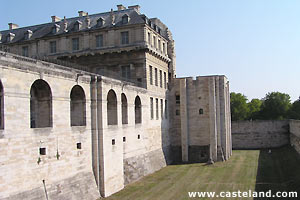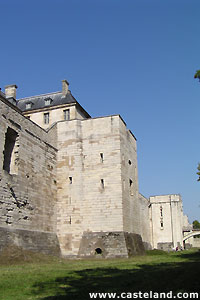|
Description of the castle

In his "reasoned
Dictionary of medieval architecture", the French architect
Eugene Viollet the Duc describes with a care meticulous person
the incredible fortress of Vincennes. We leave the word with this
expert.
1
- Courtines and turns of flanking
Under Charles V one
modified the old defense force. One had already small pieces of
artillery, which made it possible to lengthen the faces, to move
away flankings consequently. It had been recognized that the short
faces had the disadvantage, if the two close sides had been destroyed,
of ravelling the attacker and to present only one not very wide
obstacle to him, counters which it could accumulate his means of
attack. As this always against these courtines was narrow, between
two turns, as the last operations of a seat concentrated, as soon
as as a preliminary one had managed to ruin higher defenses of the
turns by fire, if they were composed of hourds, or by large projectiles,
if the galleries of the machicolations were covered with a coat
of masonry. About 1360, the courtines were thus lengthened; the
turns were spaced, took a greater surface, had sometimes right sides,
- i.e. these turns were built on rectangular level, - and were crowned
by platforms. The castle of Vincennes is a standard fortress in
conformity with a new device. The well-known plan of this place
presents a large parallelogram flanked of four rectangular turns
at the angles, of a tower (carries) also rectangular in the medium
of each small side, three square towers on one on the large sides,
and by the keep with its enclosure on the other.
The courtines between the turns are approximately 100 meters long,
which exceeds the limit of old the escarpes flanked. The turns of
angles are planted in such way, that their sides are longer on the
small sides of the parallelogram than on the large ones, in order
to better protect the doors.

The Turns of angles
are equipped with large buttresses resting on a slope going up to
the higher cornice, which is only one continuation of broad machicolations.
The three stages were arched, and on the last vault rested a platform
paved, suitable to receive, or large machines, or pieces of ordnance.
A crènelage protected the principal rafters.
Towards second half of XIVe century, one returned to the considerable
commands of the turns on the courtines, with the obvious intention
to make be used this command for the placement of machines with
long range. The higher vault, glaze of a thick shielding of notch
(dust produced by the size of the stone and used like matter "plug")
under the pavement, resisted all the projectiles launched to the
flight, by supposing that these projectiles could rise to fall down
rather high on the platform. The tower defends absolutely only top,
either by the machines of position, or, against the brought closer
attack, by the crènelages and machicolation.
2
- Considerations on the evolution heights of walls
 It
is curious to follow not does not have, since Antiquity, this constant
movement of oscillation, which, in work of defense, sometimes made
give to the turns or flankings a command on the courtines, sometimes
reduced this command and levelled the top of the turns on the level
of the courtines. Nowadays still (at the XIXe century thus) these
same oscillations are felt in the art of the fortification, and
Vauban itself, towards the end of its career, after having recommended
flankings of level with the courtines, had returned to the commands
raised on the bastions. It is that indeed, whatever the range of
the projectiles, it are only the one relative question, since the
conditions of shooting equal for are besieged as for the attacker.
If the raised commands are removed, one discovers the attacker of
less further, and one allows him to begin his work of approach more
closely; if these commands are increased, one gives an easier catch
to artillery of besieging. Also we see, during the Average Age,
and mainly since the adoption of the pieces of ordnance, the systems
to follow one another and float between these two principles.
From elsewhere a difficulty emerged formerly as it emerges today. It
is curious to follow not does not have, since Antiquity, this constant
movement of oscillation, which, in work of defense, sometimes made
give to the turns or flankings a command on the courtines, sometimes
reduced this command and levelled the top of the turns on the level
of the courtines. Nowadays still (at the XIXe century thus) these
same oscillations are felt in the art of the fortification, and
Vauban itself, towards the end of its career, after having recommended
flankings of level with the courtines, had returned to the commands
raised on the bastions. It is that indeed, whatever the range of
the projectiles, it are only the one relative question, since the
conditions of shooting equal for are besieged as for the attacker.
If the raised commands are removed, one discovers the attacker of
less further, and one allows him to begin his work of approach more
closely; if these commands are increased, one gives an easier catch
to artillery of besieging. Also we see, during the Average Age,
and mainly since the adoption of the pieces of ordnance, the systems
to follow one another and float between these two principles.
From elsewhere a difficulty emerged formerly as it emerges today.
The layout of a place in flat projection can be rational, and more
to be it because of the reliefs. With the raised commands, one can
discover with far the countryside, but one threads the ditches and
the escarpes by a plunging shooting which does not produce the effective
effect of the shaving shooting. The two conditions thus should be
met. The castle of Vincennes was thus, for time when it was raised,
an attempt which perhaps all the importance was not appreciated.
The architect manufacturer of defenses claimed to withdraw the turns
from the effect of the parabolic shooting, in their giving a considerable
relief, and it claimed to use this command, uncommon then, for the
shooting of the new machines with fire, and the large improved machines,
such as the mangonneaux ones and precision balances.
Under the reign of Charles V, one nowhere does not find, in France,
in Germany, in Italy, in England or Spain, a second example of the
provision adopted for construction of the castle of Vincennes. It
is an isolated attempt which was not followed. Here is the reason:
then (of 1365 to 1370) one started to employ pieces of ordnance
of a rather low gauge, or bombard iron short, hooped, clean has
to launch stone balls to the flight, as could do it the counterweight
machines. It was not believed that the new artillery with fire would
replace one century later these cumbersome machines, but whose shooting
was very precise and the terrible effect until a range of 150 A
200 meters. The used artillery with fire towards the end of XIVe
century in the places, consisted of tubes of iron which sent balls
of two or three books at most, or even of stones rounded. These
machines replaced with advantage the large crossbows, and could
be put out of battery behind merlons turns.
II thus interest had there to increase the relief of these turns,
because the shooting of full whip being weak, more one raised it,
more it could cause damage with besieging. Moreover, as said we
it a few moments ago, it was important to withdraw the top of these
turns from the launched projectiles from flown by the old machines.
The courtines were, relatively, to have only one less relief, in
order to poster the principal rafters which sent their squares of
goal in white to approximately 60 meters. The machines and pieces
of ordnance of the platforms of the turns covered the countryside
of large projectiles in a radius of 200 meters, and thus holding
besieging them remotely, the courtines were protected until the
moment when, by work of approach, the attackers arrived at the peak
of the ditch. In this last case, the principal rafters of the courtines
defended of it the approach and those of the turns took in side
the columns by storm by a plunging shooting.
Next
page
|





 It
is curious to follow not does not have, since Antiquity, this constant
movement of oscillation, which, in work of defense, sometimes made
give to the turns or flankings a command on the courtines, sometimes
reduced this command and levelled the top of the turns on the level
of the courtines. Nowadays still (at the XIXe century thus) these
same oscillations are felt in the art of the fortification, and
Vauban itself, towards the end of its career, after having recommended
flankings of level with the courtines, had returned to the commands
raised on the bastions. It is that indeed, whatever the range of
the projectiles, it are only the one relative question, since the
conditions of shooting equal for are besieged as for the attacker.
If the raised commands are removed, one discovers the attacker of
less further, and one allows him to begin his work of approach more
closely; if these commands are increased, one gives an easier catch
to artillery of besieging. Also we see, during the Average Age,
and mainly since the adoption of the pieces of ordnance, the systems
to follow one another and float between these two principles.
From elsewhere a difficulty emerged formerly as it emerges today.
It
is curious to follow not does not have, since Antiquity, this constant
movement of oscillation, which, in work of defense, sometimes made
give to the turns or flankings a command on the courtines, sometimes
reduced this command and levelled the top of the turns on the level
of the courtines. Nowadays still (at the XIXe century thus) these
same oscillations are felt in the art of the fortification, and
Vauban itself, towards the end of its career, after having recommended
flankings of level with the courtines, had returned to the commands
raised on the bastions. It is that indeed, whatever the range of
the projectiles, it are only the one relative question, since the
conditions of shooting equal for are besieged as for the attacker.
If the raised commands are removed, one discovers the attacker of
less further, and one allows him to begin his work of approach more
closely; if these commands are increased, one gives an easier catch
to artillery of besieging. Also we see, during the Average Age,
and mainly since the adoption of the pieces of ordnance, the systems
to follow one another and float between these two principles.
From elsewhere a difficulty emerged formerly as it emerges today.

